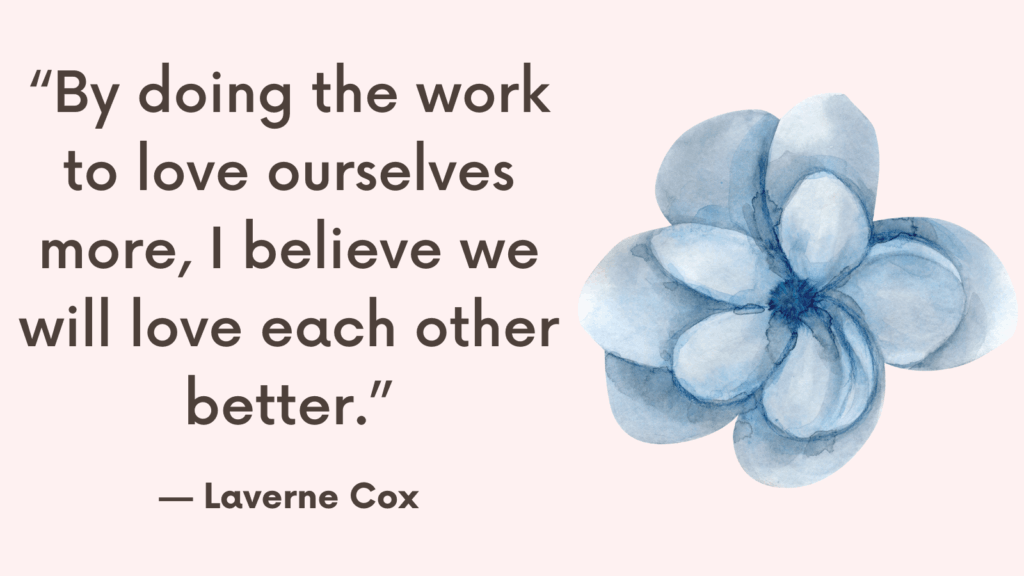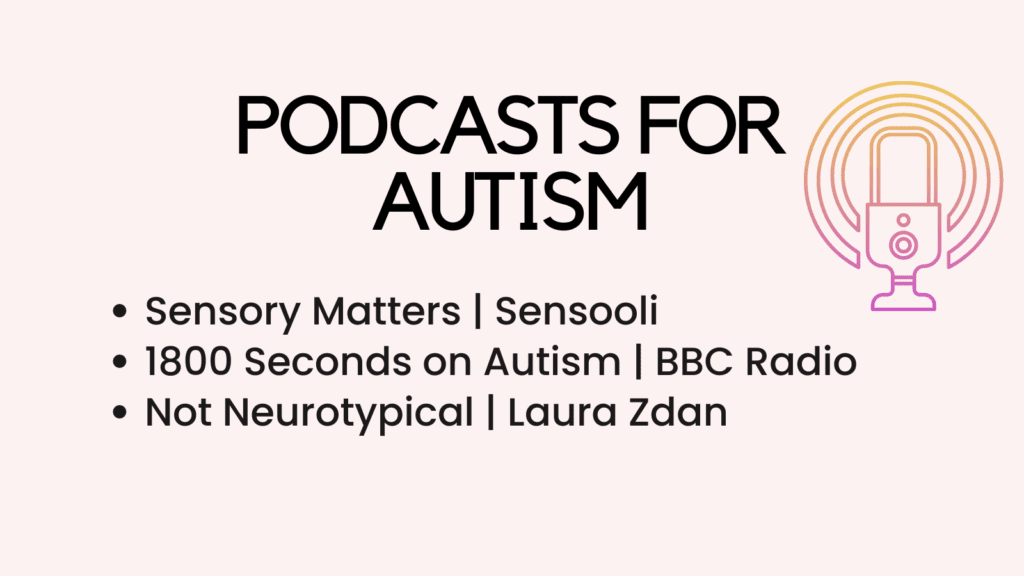In this post, you’re going to learn the difference between a shy child and one with autism and how to parent a child with autism and make your life a lot less stressful.
- Shy Toddler Vs. Autism: What’s The Difference?
- How to Parent A Child With Autism?
- 1. How To De-Escalate A Child With Autism?
- 2. Reframing Echolalia: A Child With Autism Is Not Ignoring You
- 3. Making Sense of Interests
- 4. Understanding the Child’s Fear and Trust
- 5. The Child’s Emotional Memory
- 6. The Challenge of Learning Social Rules
- 7. Educational Support Measures
- Conclusion: Accept and Express Your Feelings
Shy Toddler Vs. Autism: What’s The Difference?
The line between shyness and autism can be blurry. Both share a lot in common.
For example, a shy child may hide behind their parents, avoid eye contact, or avoid joining in at playgroups and other social settings.
Likewise, a child with autism tends to avoid eye contact and social settings.
Both shy children and children with autism may find it difficult to make friends.
So what’s the difference?
There exist some subtle differences between a shy child and an autistic child.
A shy child would usually look to their parent or caregiver for support and eventually “warm up” and show more confidence in new situations and with new people.
However, a child with autism may not look to their parent for support or “warm up” even after spending a lot of time with others.
There are other symptoms of autism that are usually easy to spot early on, such as not smiling when you smile at them, getting very upset at some noises, smells, or tastes, performing repetitive movements, etc.
How to Parent A Child With Autism?
Autism isn’t an illness.
Children with autism are progressing through developmental stages as other people do.
They don’t need to be fixed or changed. We just need to work to understand these children, and then change what we do.
We best support children with autism when we change our attitudes, and the types of support we provide.
1. How To De-Escalate A Child With Autism?
#1. Start by Asking “Why?”
Most people view behaviors such as rocking, echoing, flapping, etc. as deficits – something to manage and get rid of.
In other words, the more we can make a child look and act “normal,” the better.
This way of supporting children with autism, not only doesn’t work, but also treats the child as a problem to be solved rather than an individual to be understood.
What Should You Do?
Instead, you need to listen and pay close attention to what the child is trying to tell us, even through patterns of behavior.
It’s more effective to ask “Why?”
Why is he rocking? Why does she repeat certain phrases when she is upset?
#2. Understand Emotional Dysregulation
Usually the answer to these behaviors is that the child is experiencing emotional dysregulation. (*)
Due to underlying neurology, people with autism are especially vulnerable to everyday emotional challenges.
They experience more feelings of discomfort and anxiety, than others.
They also have more difficulty managing and expressing these emotions.
In fact, difficulty staying well regulated emotionally is a defining feature of autism.
And so, it makes more sense to focus on the underlying causes behind their behaviors than on the behavior itself.
What Should You Do?
Consider what makes your child less able to stay well regulated. This might include: unexpected change, excessive worry about an upcoming event, sensory sensitivities to touch and sound, problems in communicating, allergies, gastrointestinal issues, etc.
If your child refuses to enter the school cafeteria, this is probably not willful disobedience or a planned attempt to escape. The reason is usually the volume or quality of the noise or the chaos of the setting.
#3. Coping Strategies and Regulating Behaviors
What people label as “autistic behaviors,” are actually strategies the child uses to feel regulated emotionally.
In other words, “autistic behaviors” are simultaneously a sign of dysregulation and a coping strategy.
They are the child’s way to soothe himself and calm his mind and body.
These comforting rituals might include: carrying familiar items, moving in particular ways, repeating certain phrases, seeking sameness in an attempt to control their surroundings, chewing, or licking things, etc.
Are these behaviors an indication of Obsessive-Compulsive Disorder?
Not really. The impact of these behaviors on people with autism is quite different.
While OCD behaviors are disruptive and doesn’t serve to make the person feel better, repetitive behaviors people with autism use help them to emotionally regulate themselves so they can function more effectively.
What Should You Do?
Provide better ways to help regulate the child’s emotions and decrease his level of anxiety and confusion.
- Offer crunchy snacks to chew on
- Give him a photograph of someone’s safe
- Practice calming activities by experimenting and finding out what works best for your child, such as proprioceptive activities, vestibular activities, deep muscle work, etc.
- Offer items that provide comfort for the child, such as cushions, blankets, stuffed animals, a rocking chair, a yoga ball, etc.
- Prepare your child for transitions by providing verbal/visual reminders.
Related: Top +40 Autism Self Help Skills For Adults That Will Make Life Less Stressful (+FREE ASD Resources)
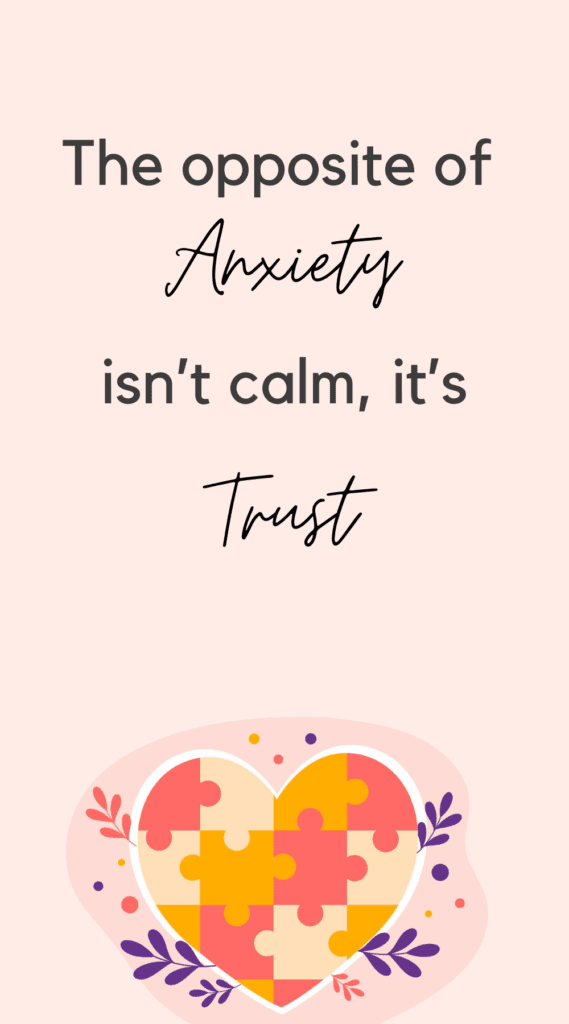
2. Reframing Echolalia: A Child With Autism Is Not Ignoring You
#1. Asking “Why?”
Sometimes, when children with autism become dysregulated they display echolalia – the repetition of spoken language, either immediately or some time later. (*)
This often manifests in a tendency to repeat words, phrases, or whole sentences, often ad infinitum.
Most people dismiss echolalia as autistic behavior and nonsense talk.
Some practices to reduce echolalia involve ignoring the child (“planned ignoring”), issuing a firm command: “Be quiet!” or “No silly talk!” But such strategies, as with other autistic behaviors, lacks understanding.
Echoing or incessant questions serve many purposes for children with autism, including emotional regulation and communication attempt.
What Should You Do?
Attempting to stop their echoing, disrupts the child’s process of learning to communicate and connect with the world.
A more effective strategy would be to ask “Why does she need to do that? What function does it serve?”
Echoing might appear to be nonpurposeful, in the sense that we cannot decipher the meaning. But most of the time, when you listen and observe, it becomes clear that the child is communicating—in his own unique way.
Some of the reasons behind echoing might include:
- Asking the same question incessantly to know what to expect and reduce anxiety and reassure himself.
- Speaking incessantly on a familiar topic to have a sense of control over a stressful conversation.
- Affirming what he understood.
- Rehearsing something he is going to say later.
- Repeating certain sounds she finds calming, as chanting a mantra might be.
- Reasoning through the situation aloud.
- Etc.
To find out why the child is using echolalia, you just need to listen, observe, and pay close attention.
#2. View Echolalia as a Learning Strategy
Children with autism struggle with communication but they usually have a strong memory and repeating back what they hear, helps them learn language. (*)
In other words, echolalia is the child’s way to acquiring language.
As the child continues to grow socially and cognitively, echoing will most likely lessen and the child learns to use more creative forms of communicating.
What Should You Do?
You can support your child by doing the following:
- Simplifying the language you use with the child.
- Breaking down sentences into words and smaller phrases.
- Adding gestures.
- Providing visual supports and writing things down..
- Etc.
These strategies help a child understand more clearly, making it less necessary to use echoing as a strategy to understand.
#3. Encourage Communication Through Listening
When the child’s early attempts to communicate are met with orders to “be quiet!” or “stop the silly talk!” he feels discouraged to work through the challenging process of figuring out what language and communication are all about.
As a result, the child often reacts by avoiding certain people, shutting down, or even giving up.
What Should You Do?
Listen, pay attention, and ask “Why?”
When you pay close attention to the reason behind echolalia, you find out that echoing is the child’s attempt to communicate.
Allowing the child to communicate is the best way to support his learning process.
Related: Autism In Women Symptoms That Are Often Overlooked
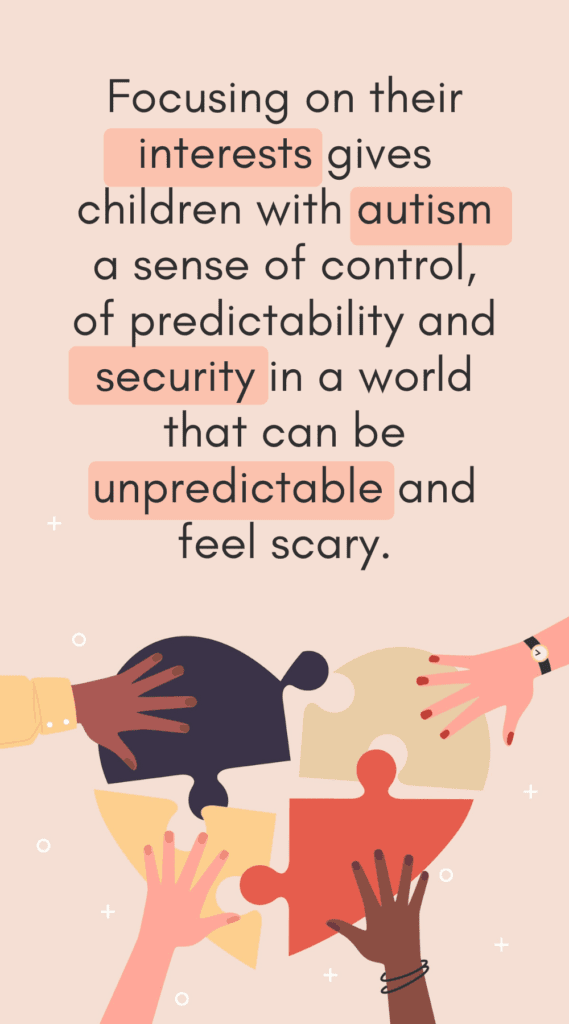
3. Making Sense of Interests
#1. Asking “Why?”
Children with autism develop different kinds of interests from subjects like animal species to music or movies. They focus on their interests and talk about them nonstop.
It’s important to understand what’s motivating the child to speak about his interests in a certain situation.
Is there a pattern? Could it be when the child feels stress and so he’s trying to calm himself down? What might be causing the stress? How can you alleviate the anxiety?
These interests serve many purposes including giving the child a sense of control and predictability in a world that is often confusing and unpredictable. (*)
Because connecting socially is challenging, many children with autism use their interests to build connections and engage in conversations more comfortably.
What seems like an irrelevant question (“What’s your favorite breakfast cereal?”) can be a strategy to connect.
#2. Building on Interests
Some people might view interests as another undesirable symptom of autism that can make it even more difficult for the child to fit in. As a result, they try to discourage the child’s interests or suggest interests that are more conventional.
What they don’t realize is that the child’s interest is another strategy the child uses to regulate his emotions and make sense of the world.
What Should You Do?
A more effective way to support the child, is to use his interests as a way to motivate him and expand his outlook.
With creativity, you can use the child’s interest to motivate him to become more engaged socially and to solve problems. (*)
#3. “Time and Place” Strategy
Explain to the child that there’s nothing wrong with his interest but that sometimes other people want to hear about his interests, but other times they’re not as interested.
You can devise a list of times and places when it’s appropriate to focus on or speak about an interest, a list when it’s not appropriate, and a list of people with whom it’s okay to converse about these interests.
For example, “you should not be taking about your interest during your math class, but at dinner time, we can hear about it.”
Related: Autism Resources For Adults (Information, Podcasts, TED Talks, Books)
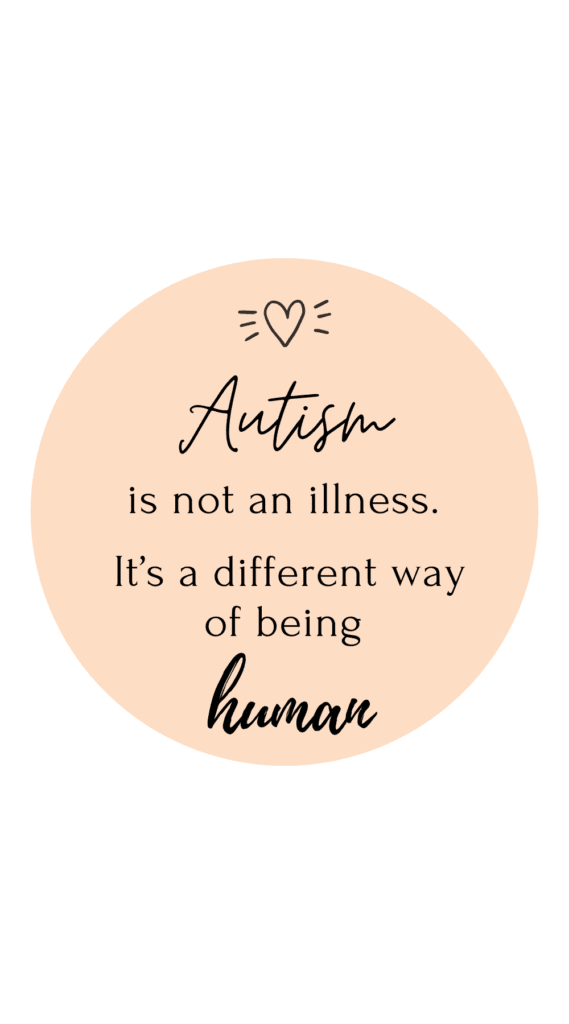
4. Understanding the Child’s Fear and Trust
#1. Asking “Why?”
Lack of trust, pushes us to react with fear and seek ways to control our lives and relationships. This tendency is even more pronounced in people with autism.
People might find the reaction of children with autism out of proportion to the problem. Even seemingly trivial sources of frustration, such as changes in routine and rules, especially without warning, can trigger a full-blown meltdown.
But keep in mind that the child already finds his world confusing. Any violation to his own sense of order can constitute a threat.
Lack of trust can be related to other people too.
Not being neurologically hardwired with the ability to read body language intuitively and predict the behavior of others, people with autism find most of what other people do very sudden and threatening. It’s exhausting when all of your energy is focused on staying in a heightened, hypervigilant state of alert.
Other people with autism can have the opposite reaction. They appear less alert, moving and reacting more slowly than others. But that doesn’t mean they don’t experience anxiety.
When they feel dysregulated, they tend to internalize their anxiety rather than directing their behavior outward, which makes their outbursts or meltdowns difficult to predict.
#2. Helping The Child Overcome Fear
To cope with anxiety or dysregulation, the child might try to exert control over the situation or the conversation. When a child talks incessantly about an interest, he might be feeling anxious in a social situation and so speaking about his area of interest helps him feel more in control.
Some professional try to seize control from the child, but that only causes increased dysregulation.
What Should You Do?
Developing trusting relationships help the child with what he perceives as a confusing, unpredictable, and overwhelming world.
Rather than demanding or pressuring the child to change, we need to change first. Often it’s people surrounding the child that increase anxiety and fear.
* Acknowledge the child’s emotional state – When the child is feels emotionally dysregulated and engages in what appears like an that inappropriate or disruptive behavior, Instead of ignoring him or asking him to stop, pause and ask yourself, “What could he be feeling right now? What can I do to lessen the anxiety?”
* Acknowledge the child’s attempts to communicate – Help the child feel heard. This might take some patience, but without feeling heard, trust cannot be built.
* Practice shared control. – Instead of imposing external control, try offering more choices, to giving the child a voice in planning his schedules and activities, and any other significant aspects of his life.
* Be reliable and clear – Make the effort to clearly explain social rules and why they exist. Also make sure you’re clear about your intentions and consistent.
Related: Best 10 Autism Books For Parents
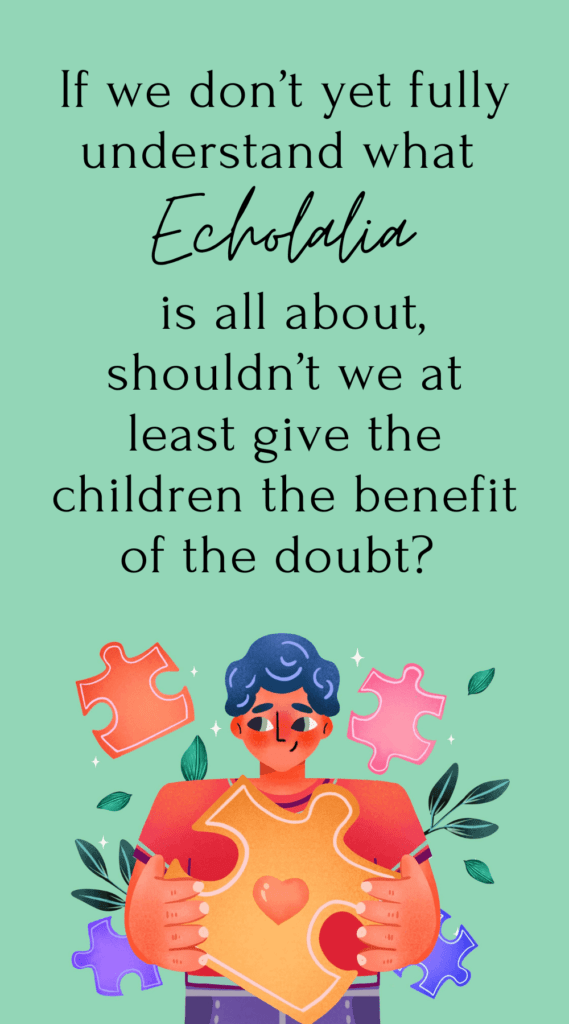
5. The Child’s Emotional Memory
A child can have a powerful ability to remember past memories, and with the challenges the child with autism has to face, he can accumulate more stressful experiences than typical peers.
This makes a seemingly small association (hearing the word “Doctor”) can trigger what appears to be a disproportionate reaction (feeling as if he’s reexperiencing a stressful incident in the pediatrician office taking a shot). (*)
How Can You Tell Whether The Child is Having Emotional Memory?
When you find the child’s behavior baffling or inexplicable, he’s probably caught up in a memory so intense and vivid that it feels as if the event is happening all over again.
What Should You Do?
* The first and most important thing you can do to help a child cope with emotional memory is to acknowledge and validate his experience and provide support to help reduce emotional dysregulation (bring music and headphones, favorite toy, etc).
Trying to minimize the child’s experience or ignoring it altogether don’t work and possibly make the child even more anxious.
* Figure out the source of anxiety and try to avoid it.
* If the source of anxiety isn’t avoidable, acknowledge the child’s experience and try not to force things. This can help the child feel safer and empower him to face his fear.
* Create positive associations. If the child feels anxious when going to a doctor’s appointment, like that with something his loves and brings him joy, like going to the zoo afterwards, or buying him his favorite treat.
6. The Challenge of Learning Social Rules
#1. Asking “Why?”
Nearly every person with autism has some degree of difficulty understanding the social world’s hidden rules and expectations, and nuanced use of language.
Sometimes, this lack of innate understanding can manifest itself in behaviors that appear to be rude or abrupt.
Social rules are further confusing to a child with autism because even when taught the rule, he encounters its exceptions more frequently than the rule itself.
The child tries hard to get it right, but oftentimes, ends up being misunderstood.
#2. Help by Being More Direct
Direct requests always work better than subtle hints. In your communication with people with autism, you should be as direct as possible.
It can also be helpful to use “comprehension checks” and ask the child if he understands what you told him, and, if not, offer an explanation.
It’s also helpful to teach the child the concept of nonliteral language and explain the different meaning of words and phrases, such as idioms.
The child can take idioms, such as “Stabbed in the back,” or “Spill the beans” literally, which can be quite confusing.
#3. Teach “Social Thinking” Rather than “Social Skills”
People would often focus on teaching social skills, such as making eye contact, rather than social thinking. They focus on making the child appear “normal.”
But appearing to be “normal,” doesn’t help the child read social situations, or understand other people’s perspective.
Many children with autism avoid making eye contact because they find it uncomfortable or because it takes focus and energy to do so, which distracts them from focusing on what the person is saying or thinking about what they themselves want to say.
What Should You Do?
It’s more helpful to teach the child “social thinking” by explaining the unspoken obligation to let someone know you’re listening. The child can understand that he can indicate he’s paying attention by nodding or saying “Uh-huh,” etc.
The child can also be taught to offer an explanation about how looking into someone’s eyes causes them discomfort, so the other person won’t assume that the child is inattentive or bored.
7. Educational Support Measures
Although every child needs an individualized support plan to meet her specific needs, the following suggestions could help when settling into a new educational setting:
#1. Put the support plan in place before he starts at your school.
#2. Meet her and show her around before she starts. Explain to her where she will be and what’s required.
#3. Find him a peer to help him make his way into the social side of things.
#4. Use schedules and other clear information to help her make sense of what will happen and when.
#5. Children with ASD generally comply and stay out of trouble. If this is not the case, consider that maybe he didn’t understand what is required of him before reacting.
#6. If she’s being “too honest”, do not take it personally. She is not meaning to intentionally annoy you.
#7. She needs rules to navigate the world. Consider whether you have rules and whether you and others are adhering to them.
She will feel confused and distressed if there are no rules or if others don’t appear to have to stick to them.
#8. Consider training your staff in ASD.
#9. Non-academic skills are as important as academic ones. Don’t assume that because she’s smart (or average) and highly articulate (her words), she won’t need to be taught how to hold a conversation, or use the bathroom.
#10. Give her the heads-up on the topic and content of lessons in advance and let her research it on her own to reduce her surprise and increase her ability to participate in the lessons.
#11. Make sure she understands the requirements of assignments by providing her guidelines on length, content, timescale, and priority.
#12. Give her the opportunity to ask questions and ask for help. Asking for help may equate to weakness or failure, so she may not ask for it.
This is why you need to keep an eye on her and let her know that help is always available.
#13. Help him engage by bringing his interests into the curriculum.
#14. For teamwork, give him a role where his strengths lie. He is likely to excel in planning, research and possibly writing up results.
Conclusion: Accept and Express Your Feelings
Taking care of a child with autism brings powerful feelings of guilt, resentment, anxiety, anger.
A mother might express how her son’s endless chatter about his interest, drives her crazy, but also feel guilty, thinking she shouldn’t feel that way.
But you don’t have to be a saint to raise a child with autism. Your feelings are both natural and legitimate.
The experience can leave you feeling lonely and isolated. Find a community that can relate and where you can feel understood, accepted, and welcomed.
What’s Next? Top +40 Strategies For Adults With Autism to Make Life Less Stressful (+ASD Free Resources)
Resources
- Portions of this article were adapted from the book Uniquely Human: A Different Way of Seeing Autism, © 2015 by Barry M. Prizant. All rights reserved.
Other Resources
Autism Speaks A prominent autism research and advocacy organization. The website contains links to apps, tool kits and a resource guide.
The Arc – Autism Now The Autism NOW Center’s resources include fact sheets, webinars, a newsletter and a call center.
- Autism signs & diagnosis in children | Raising Children Network
- Signs of autism in children – NHS (www.nhs.uk)
- Signs and Symptoms of Autism Spectrum Disorders | CDC
- Tips for Parenting A Child With Autism (webmd.com)
- What Is Autism? | Autism Speaks
- Autism (ASD): Symptoms, Causes, Tests, Treatment & More (healthline.com)
- Helping Your Child with Autism Thrive – HelpGuide.org
- Autism Spectrum Disorder (for Kids) – Nemours KidsHealth


